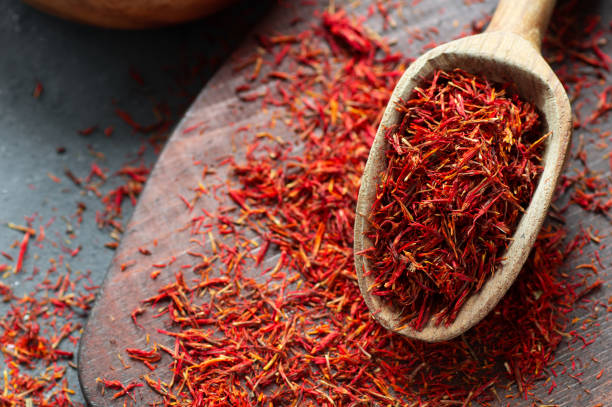Saffron's Secret: Unveiling the Golden Spice's Culinary Magic
Saffron, the world's most expensive spice, has long captivated chefs and food enthusiasts alike. This article delves into the fascinating world of saffron, exploring its rich history, unique cultivation process, and diverse culinary applications. Discover how this golden thread can elevate your dishes and transform your cooking experience.

The Flavor Profile: Decoding Saffron’s Unique Taste
Saffron’s flavor profile is as complex as its cultivation process. Its taste is often described as a harmonious blend of earthy, floral, and slightly bitter notes, with a hint of sweetness. The aroma is equally intricate, offering a mix of honey-like sweetness and a subtle metallic tang. When used in cooking, saffron imparts a distinctive golden hue to dishes, making it as visually appealing as it is flavorful. The key compounds responsible for saffron’s unique sensory properties are safranal (aroma), crocin (color), and picrocrocin (taste). These compounds work in synergy to create saffron’s unmistakable flavor profile. Interestingly, the potency of these compounds can vary based on the saffron’s origin, harvest time, and storage conditions, making each batch a unique experience for the discerning palate.
Beyond Paella: Innovative Culinary Applications
While saffron is traditionally associated with dishes like Spanish paella and Italian risotto, innovative chefs are constantly finding new ways to incorporate this golden spice into their creations. In modern cuisine, saffron is making appearances in unexpected places, from artisanal ice creams to craft cocktails. Pastry chefs are infusing saffron into delicate macarons and rich custards, while mixologists are using it to add depth and complexity to their signature drinks. Saffron-infused honey is gaining popularity as a gourmet condiment, perfect for drizzling over cheese or incorporating into vinaigrettes. In savory applications, chefs are experimenting with saffron in fusion cuisines, creating unique dishes like saffron-spiced sushi rolls or saffron-infused barbecue sauces. These innovative uses showcase saffron’s versatility and its ability to elevate both sweet and savory dishes across various culinary traditions.
The Science of Saffron: Health Benefits and Nutritional Value
Beyond its culinary applications, saffron has been the subject of numerous scientific studies exploring its potential health benefits. Research suggests that saffron may have antioxidant, anti-inflammatory, and mood-enhancing properties. Some studies have investigated its potential role in improving cognitive function and reducing symptoms of depression. Saffron is also being explored for its possible effects on eye health and cardiovascular function. From a nutritional standpoint, saffron is rich in manganese, vitamin C, and various antioxidants. While the amounts used in cooking are typically too small to provide significant nutritional benefits, the incorporation of saffron into a balanced diet may offer subtle health advantages. As research continues, the intersection of saffron’s culinary appeal and potential health benefits presents an exciting area for food scientists and nutritionists to explore.
Sourcing and Storage: Maximizing Saffron’s Potential
Given saffron’s high cost and delicate nature, proper sourcing and storage are crucial to maximize its culinary potential. When purchasing saffron, opt for whole threads rather than ground powder, as this allows for better quality control and longer shelf life. Look for saffron with vibrant red color and avoid threads with yellow or orange hues, which may indicate lower quality or adulteration. Reputable sources and certifications, such as Protected Designation of Origin (PDO) for Spanish saffron, can help ensure authenticity. Proper storage is equally important: keep saffron in an airtight container away from light and heat. When stored correctly, saffron can retain its potency for up to two years. To maximize flavor extraction, many chefs recommend soaking saffron threads in warm liquid (water, broth, or milk) for about 20 minutes before adding them to a dish. This process, known as “blooming,” helps release the spice’s full flavor and color potential.
Saffron Savvy: Tips for Culinary Excellence
-
Always use saffron sparingly; a little goes a long way.
-
Toast saffron threads lightly before use to enhance their aroma.
-
Avoid cooking saffron for extended periods to preserve its delicate flavor.
-
Pair saffron with neutral-flavored ingredients to let its unique taste shine.
-
Experiment with saffron in sweet dishes like ice cream or rice pudding.
-
Try infusing saffron in olive oil for a vibrant, flavorful drizzle.
-
Combine saffron with citrus zest to create a bright, complex flavor profile.
-
Use saffron to add depth to vegetarian dishes as a meat-free flavor enhancer.
Saffron’s allure lies not just in its distinctive flavor and color, but in the rich cultural tapestry and culinary innovation it represents. As we continue to explore and reimagine the use of this golden spice, saffron remains a testament to the enduring power of unique, high-quality ingredients in the culinary world. Whether you’re a professional chef or an adventurous home cook, incorporating saffron into your culinary repertoire can open up a world of flavors and possibilities, elevating your dishes from ordinary to extraordinary.





